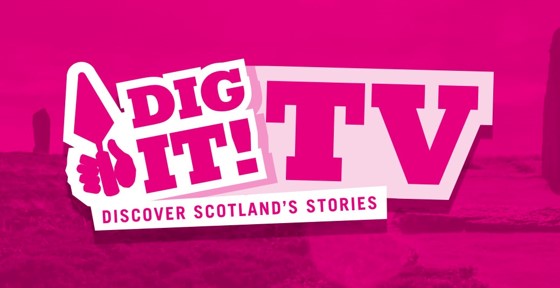This is a joint project with Archaeology Scotland and DigIt!, with the support of the Castles Studies Trust to promote some of the lesser known castles in Southern Scotland. It is running in 2018.
Aim of the work:
The goal of this project is to promote engagement with Southern Scotland’s castles by enhancing public understanding and knowledge of the castles, their purpose, their history and their relevance, particularly the lesser-known and least visited sites.
Why?
49% of people living in the UK have never visited one of Scotland’s 2,000 Castles. Moreover, those that do visit castles focus on a few well-known ones. Edinburgh Castle received 1,647,351 visitors in the last year but Stirling Castle (the second most visited HES site) saw only 447,512 visitors and smaller castles even less – MacLellans Castle, only received 1,807 visitors. A few castles get the lion’s share of attention in Scotland, but there are thousands of castles with fascinating stories to tell. Dig It! TV – Backyard Castles: Southern Scotland aims to encourage people to learn more about the castles in their own backyard.
84% of young people get their news online and through social media. Dig It! TV – Backyard Castles: Southern Scotland will also aim to fill the knowledge gap created by the shift away from traditional broadcast media and disseminate information by engaging newer and younger potential castle enthusiasts on their preferred platforms – raising their awareness of Scotland’s castles i.e. their purpose, their history and their relevance.
To meet those aims, our project has the following objectives:
- Combine existing research with site visits to create higher-quality educational and entertaining digital content that
can reach new audiences; - Raise the profile of castles with a focus on “hidden gem” sites (lesser-known sites)
- Ensure that the information on these castles is freely accessible to an international audience on different online
channels, for example:
a. Over a billion YouTube users
b. The world’s fifth most visited website: Wikipedia
c. Live video streaming sites such as Periscope - Track this work to see if we are educating more people about Scotland’s castles
To help advance the understanding of castles, Dig It! TV will produce a series of short videos which will be released on the Dig
It! TV YouTube channel https://www.youtube.com/channel/UCN8X1dl1KHzOU2tIa_Dm47w . The presenter will research each
castle to develop the content and adapt the information for a YouTube audience before visiting the site for filming.
Wikipedia is now the fifth most popular website in the world and ‘the greatest open educational resource the world has ever seen.’ It is most people’s first port of call for information, and in some cases, their last. Google and Wikipedia are vital sources of information for researchers and members of the public alike, especially if there are limited interpretation boards at a castle.
Moreover, a recent study has shown that ‘incorporating ideas into a Wikipedia article leads to those ideas being used more in the scientific literature’ and that ‘the results suggest that increased provision of information in accessible repositories is a cost-effective way to advance science. We also find that such gains are equity-improving, disproportionately benefitting those without traditional access to scientific information.’
Wikipedia may be the most cost-effective method for disseminating information and research about castles. Unfortunately, most of the Wikipedia articles for the castles that we are targeting have poor Wikipedia articles with
limited information. As part of this project, we would run several “editathon” events where people are trained by WikiMedia UK volunteers to edit articles. They would then edit the Wikipedia articles of this project’s selected
castles to improve them. In addition, while we are filming the videos at the castles, we will also take photographs and upload them to WikiCommons to create a bank of high-quality free-to-use images of the castles. Existing
WikiCommons and Wikipedia tools will allow us to track where on-wiki images are being used, and how often those articles are viewed.
References
1 Visit Scotland 2017. Castle of Thousands. http://mediacentre.visitscotland.org/pressreleases/castle-of-thousands-2331940
2 2,000 castles is a conservative estimate. It is upwards of 3,000 if you include castellated buildings. Other estimates have it at 4,000.
3 Historic Environment Scotland 2017. Historic sites break tourism record with four million visitors. https://www.historicenvironment.scot/about-us/news/historic-sites-break-tourism-record-with-four-million-visitors/
4 Oxford University 2017, Where do People get their news? https://medium.com/oxford-university/where-do-people-get-their-news-8e850a0dea03
5Jim Groom, Instructional Technologist, #OER16 Conference.
6 Thomas & Hanley 2017. Science Is Shaped by Wikipedia: Evidence from a Randomized Control Trial
https://papers.ssrn.com/sol3/papers.cfm?abstract_id=3039505
